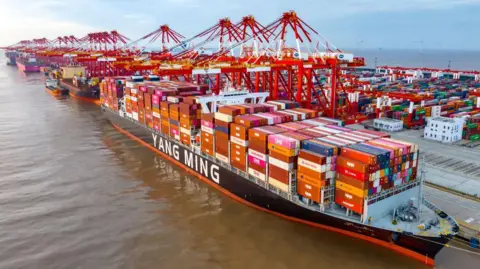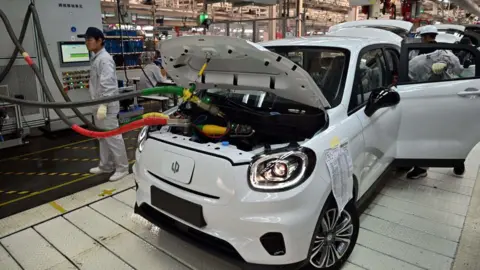The shadow of ‘Trump 2.0’ is looming over the global economy.

 getty images
getty imagesInflation, interest rates and tariffs mean that 2025 is shaping up to be an interesting year for the global economy. According to the International Monetary Fund, growth is expected to be “stable yet very low” at 3.2%. So what could this mean for all of us?
Just a week before Christmas a welcome gift arrived for millions of American borrowers – Third consecutive interest rate cut.
However, stock markets fell sharply as US Federal Reserve Chairman Jerome Powell, the world’s most powerful central banker, made clear he did not expect to cut as much in 2025 as he expected, as the fight against inflation continues. Is.
“From here on out, this is a new phase, and we will remain cautious about further cuts,” he said.
In recent years, the Covid pandemic and the war in Ukraine have led to a sharp rise in prices around the world, and although prices are still rising, the pace has slowed down significantly.
Despite this November saw boost inflation By 2.7%, 2.2% and 2.6% in the US, Eurozone and UK respectively. It highlights the difficulties that many central banks face in the so-called “final stages” of their fight against inflation. Their target is 2%, and this may be easier to achieve if economies are growing.
However, the biggest headwind for global growth “is uncertainty, and uncertainty is coming from what could come from the US under Trump 2.0”, says Luis Oganes, head of global macro research at investment bank JPMorgan. Are.
Since Donald Trump won the November election, he has continued to threaten new tariffs against major US trading partners. China, Canada and Mexico.
“The United States is pursuing a more isolationist policy, raising tariffs, trying to provide more effective protection to American manufacturing,” Mr. Oganes says.
“And even though it’s going to support U.S. growth, at least in the short term, it’s certainly going to hurt many countries that depend on trade with the U.S.”
According to Maurice Obstfeld, former chief economist of the International Monetary Fund and former economic adviser to President Obama, the new tariffs could be “particularly devastating” for Mexico and Canada, but also “damaging” for the US.
He cites car manufacturing as an example of an industry that “depends on a supply chain spanning three countries. If you disrupt that supply chain, you will have massive disruptions to the auto market”. .
He said that this is likely to increase prices, reduce demand for products and harm the company’s profits, due to which the level of investment may fall down.
Mr Obstfeld, now with the Peterson Institute for International Economics, says: “Introducing these types of tariffs in a world that is so dependent on trade could be harmful to growth, putting the world into recession. Is.”
Tariff threats have also played a role in forcing resign Canadian Prime Minister Justin Trudeau.
 getty images
getty imagesEven though the majority of what the US and China sell to each other is the same already subject to tariffs From Donald Trump’s first term in office, the threat of new tariffs poses a significant challenge to the world’s second-largest economy in the coming year.
President Xi Jinping acknowledged this in his New Year address “Challenges of uncertainties in the external environment”But said the economy was on an “upward path”.
Exporting cheap goods from Chinese factories is important for China’s economy. The decline in demand as tariffs push up prices will add to many of the domestic challenges the government is trying to address, including weak consumer spending and business investment.
Those efforts are helping, according to the World Bank, which raised its forecast for China’s growth in late December From 4.1% to 4.5% In 2025.
Beijing has not yet set a growth target for 2025, but it thinks it is on track to reach 5% last year.
According to Mara Warwick, the World Bank’s country director for China, “Addressing challenges in the property sector, strengthening the social safety net, and improving local government finances will be essential to unlocking a sustained recovery.”
According to Michael Hart, president of the American Chamber of Commerce in China, those domestic struggles mean the Chinese government is “more welcoming” of foreign investment.
Tensions and tariffs have increased between the US and China under Biden’s presidency, meaning some companies are considering shifting production elsewhere.
However, Mr Hart points out that “it took 30 to 40 years for China to emerge as such a strong supplier manufacturer”, and while “companies have tried to mitigate some of those risks… now no “China is not ready to change completely.” ,
One industry that is likely to remain at the center of global trade battles is electric vehicles. More than 10 million were manufactured in China last year, and that dominance has cost the US, Canada and the European Union (EU). impose tariffs On them.
Beijing says they are unfair and is challenging them at the WTO.
However, the possibility of Donald Trump imposing tariffs concerns the EU.
“Trade restrictions, protectionist measures, are not conducive to growth and will ultimately have an impact on inflation that is largely uncertain,” European Central Bank President Christine Lagarde said last month. “(But) in the short run, it’s probably net inflationary.”
Germany and France are the traditional engines of Europe’s economic growth. but their poor performance Despite a recent pick-up in growth amid political instability last year, the eurozone risks losing momentum in the year ahead.
That is, unless consumers spend more and businesses increase their investment.
Tax and wage increases in the UK may also result in higher prices, According to a survey.
One obstacle to cutting eurozone interest rates is that inflation remains at 4.2%. This is more than double the 2% target, and strong wage pressures are hindering it from falling further.
The same is true in the US, according to Sander van ‘t Noordende, chief executive of Randstad, the world’s largest recruitment company.
“For example, in the US, (wage inflation) is still going to be around 4% in 2024. In some Western European countries, it’s even higher than that.
“I think there are two factors. There’s a shortage of talent, but of course inflation and people demanding to get more for their work.”
Mr van ‘t Nordende says many companies are passing those extra costs on to their customers, adding upward pressure on general inflation.
He says the slowdown in the global job market reflects a lack of “dynamism” in companies and that economic growth is important to reverse this.
“If the economy is doing well, businesses are growing, they start hiring. People see interesting opportunities, and you just start seeing people moving around.”
 getty images
getty imagesOne person who will start a new role in 2025 is Donald Trump, and a number of economic plans including tax cuts and deregulation could help the US economy grow.
Although much will not be revealed until he returns to the White House on Jan. 20, JPMorgan’s Mr. Oganes says, “Everything points to continued US exceptionalism at the expense of the rest of the world.”
He expects inflation and interest rates to continue falling around the world, but warns that “a lot of this will depend on what policies are implemented, especially from the US.”






